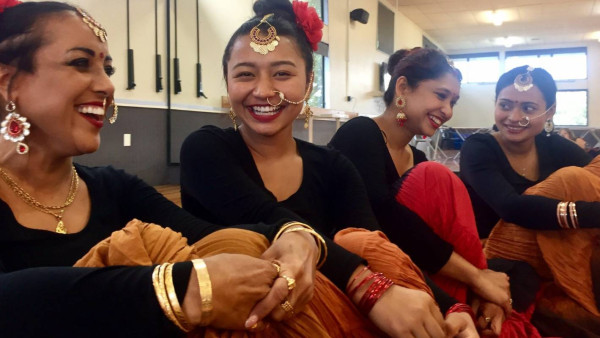Scientist Profile
At first, she thought it was a scam.
An email from an unknown sender from what appeared to be from an overseas location claiming Tanushree Gupta was a finalist for a prestigious award.
The AgResearch microbiologist had only recently returned from a long overdue catch-up with family in India and was recovering from jet lag and a travel bug.
“I was still sick and not really thinking straight. I read that e-mail and I just closed it off thinking this must be a scam. Then when I just got my mind sorted……I did some investigating.”
The email address checked out and was followed by another a few days later saying, not only was she a finalist, she’d won the Basil Jarvis Prize at the Applied Microbiology Awards.
“I couldn’t believe it and needed to look at [Applied Microbiology International's] Facebook and LinkedIn pages and through a few people profiles before I’d let myself think maybe it was legitimate.”
Tanu broke the news to her team leader, Gale Brightwell, and they discovered the award came with an all-expenses paid trip to the ceremony in London. Within a few days of thinking she was being scammed, Tanu was rubbing shoulders with the best microbiologists in the world at the Science Museum in swanky south Kensington.
She’d entered with no specific hope other than bringing her work to the attention of people who might be interested in funding it.
“We spend a lot of time in proposal writing and not getting anything. This time there were a lot of happy tears because people were noticing our work. The event was full of great scientists, and I had so many great conversations which I have continued after the event over LinkedIn. Most importantly, I was proud of representing AgResearch and New Zealand there.”

Tanu Gupta makes her acceptance speech in south Kensington, London.
Tanu stresses the word our. The award, she says, reflected the work her teams does.
“The method development for which I won the award took almost a year with constant work, including weekends. It was during the time that I found my niche in the team. My PhD students played an important part. The method was a core part of their research.
“Dr. Amila Nawarathna helped find natural antimicrobials from anaerobic bacteria and Alexis Risson helped identify spoilage and pathogenic spore forming bacteria in sheep milk. My team leader, Gale Brightwell, also encouraged me to pursue these crazy ideas.”
The award confirmed Tanu’s rising star status in the world of microbiology, and how her work has advanced the understanding of microbiologists across the world.
What was the problem that Tanu solved?
A few years ago, Tanu and her team became aware of the short comings in some of the internationally accepted and published bacterial testing regimes they were using, particularly in a dairy environment, which provided an opportunity to come up with some answers to a complex problem.
“We started to recognise that not all the recognised processing conditions for killing or stopping the growth of spore forming bacteria were working as well as they might. When bacteria are in the form of spores, they are highly robust and resilient to environmental conditions, including processing technologies and heat. This was a problem in a New Zealand context because we wanted to look at what and where are higher numbers or a prevalence of these spore forming bacteria on a dairy farm.
“We’d take samples from feed, soil, silage, maze, grass or whatever feed was fed to the animals, including swabs from milking cups and raw milk as well. From that I had that whole continuum, from one end to the other, with the aim to grow bacteria from those samples on a specific media, see the morphology of the bacteria, and then do the phenotypic analysis to find out what these bacteria are.
“We used the lab manual and methods used in papers.
“We used media with egg yolk to isolate Clostridium species and incubated bacteria using other specific media aerobically to kill off the Bacillus.
“But we couldn’t get a clear demarcation even when using the method to get the growth of anaerobic bacteria under anaerobic conditions.
“Some of the bacteria were actually able to change their metabolism and grow in the absence of oxygen as well. They were growing anaerobically. Some of them were proliferating so happily that they were all over the media and I could not identify or isolate species”.
Tanu’s background placed her in a unique position to help tackle the problem.
Initially, she’d planned to be a food technologist.
“I was always attracted towards how we can change the genetics of something and intrigued about understanding how genes actually work together to form such big things like a human being or a plant, you know, or bacteria which we can't even see.
“I did a Masters thesis at Punjabi University looking into designing different vector systems which would produce antimicrobials in certain bacterial strains.
“I got a role as a research fellow in the National Dairy Research Institute in India, where I worked with enzyme technology for the dairy industry. And after that I thought that is what I am going to do.
“But then I got this really cool opportunity to study antibiotic resistance in nosocomial pathogens, which were circulating in hospitals.
“It intrigued me, and although it was microbiology, it was a whole different set of microbial medical species, so it was totally a new field for me. I struggled a lot. I have to be open about this. I struggled a lot and I don't think my supervisor really liked me because he had this medical background.
“I was a food microbiologist, and I was trying my level best to understand medical microbiology.
“I did my PhD in antibiotic resistance and I'm still intrigued by that, but now at AgResearch I have found my niche. I work with spore forming bacteria in the food chain, whether it's meat or it's dairy. And because I know how to adapt, I'm also moving into new areas, such as animal health, which is a very important area to focus on, especially when we talk about facial eczema.”
Finding a method among the madness
Tanu’s food and medical microbiology research, coupled with hands-on lab experience, *inspired her to create a new method to differentiate bacteria.
The “text book” method to distinguish anaerobes and aerobic bacteria wasn’t effective in a New Zealand farm context. Bacteria (bacillus) were surviving the two-day incubation period. Samples of what were assumed to be Clostridium bacteria were in fact a mixture of the two.
“We started to realize that what the manual suggested may not be always right. You have to work it around according to your own situation.
“And this raised the question that perhaps a natural anti-bacterial might be involved at some stage in the method. That a specific group of anaerobic species were able to produce some secondary metabolites as part of their metabolism.
“We started isolating those anaerobic species and then whole genome sequencing them. We grew them individually or together. We tested the efficacy against different food pathogens and against different food spoilage microorganism, fungus as well. Through a lot of hard work we found the specific anaerobic bacteria that were untouched, that had the ability to produce antibacterial and antifungal metabolites thanks to our new method.”
Tanu said publishing their findings helped change the understanding of how bacteria interacts and has opened up research into new applications of antibacterial and antifungal metabolites. More work needs to be done. But there are several obvious applications in packaging and preventing food spoilage.
Tanu’s husband, Sandeep Gupta, is a senior scientist in the ethical agriculture team and was also able to attend the award ceremony and use the opportunity to talk about his work with other attendees.
Sandeep Gupta and Tanu are partners at work and home.
In her acceptance speech, Tanu paid tribute to Sandeep.
“He is a tremendous support and while our work is different, we are able to discuss our science and share our thoughts and I have a tremendous amount of respect for the work he’s doing on his Smart Idea research and the work he put in to make that a success.”
Tanu strives to keep her work and life in balance. One of her main ways of doing this is through her love of dance. Tanu runs the Shree Dance Academy and is trained in the traditional Indian style of Kathak, a storytelling form of dance that finds its origins in ancient mythology through movement, song and music.

Tanu (third from left) with students from her dance academy. "We love to laugh," says Tanu.
To watch Tanu dance click here:(external link)
“I'm quite lucky that I am living a life of two passions that I really love. One is science and one is dance.
“It is a magnificent part of my life. I think the academy is the only dance school of its type in Palmerston North or even in the lower North Island. I've got eight different ethnic groups, and we all come together. We learn together. We laugh together. Whatever is happening in our lives, we share together. It's like a family.”
Tanu says she is inspired by her students – many of whom are juggling busy lives with families and study.
“We have people with so many backgrounds but we all enjoy dancing because that's one place where we take all our stresses out”.
The future looks bright for Tanu.
She has exciting new avenues to explore looking at enzymes that can chew or degrade plastics and a collaboration with Sandeep using CRISPR technology to develop new methodologies to detect food pathogens and spoilage organisms in food.
Doctor Tanushree Gupta is a science star on the rise.